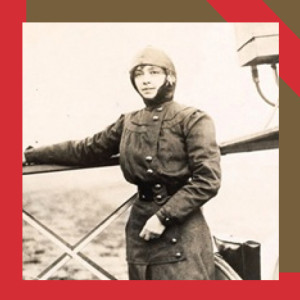Outside of France, the name of Marie Marvingt does not ring a bell in the ears of either WWI or aviation historians. However, the story of Marie Marvingt must not be ignored in the story of women in the First World War, as she is one of the leading pioneers in both aviation and air ambulance history. Marie was born in Aurillac in 1875 to progressive parents who encouraged her love of daring escapades and sports. By the time Marie was twenty-four in 1899, she had already competed in skiing, swimming and fencing competitions across France, and had gained her driving licence. If these adventures were not enough, Marie undertook solo ballooning expeditions across Europe before getting her pilot’s licence in 1910. This made Marie Marvingt one of the first women in France, as well as the world, to obtain an aviator’s licence.
Between 1910 and 1913 Marie Marvingt came up with an ingenious idea for medical evacuation by air ambulance in the case of war. In relation to the design of the air ambulance, Marie is quoted as saying
My current dream is to place the airplane in the service of military casualties. My airplane would be a Deperdussin monoplane with three places, powered by a 100hp Gnome motor, and equipped with radio. It would provide information to the senior doctors, and would be able to resupply aid posts … To construct it I have started a series of conferences around France. Piece by piece, I will accumulate what seems necessary, and I will realise my greatest desire for France. It will be one of the greatest joys of my life.
Marie realised that if she completed her above mentioned design the lives of fighting soldiers could be saved more easily than by transportation by horse or motor-vehicle. Marie approached various different factories until the Deperdussin factory agreed to make her air ambulance in 1913. However, Marie’s dreams were not fully realised as the bankruptcy of the factory and the outbreak of WWI meant that her dreams had to be put on hold. Although there were some medical evacuations by air in WWI, it was thought too risky to chance a human life on the early and quite flimsy aeroplanes.
This setback did not deter Marie from her pursuit of action during the Great War. Marie disguised herself as a French lieutenant and served on the French lines with the rest of her regiment. However, she was discovered to be a woman and was sent home. Nonetheless, this did not deter Marie’s spirit in her determination to be part of the action on the front lines. She used her Red Cross nursing skills to join an Italian Alpine regiment, which eventually led to her being used as a combatant because of her previous battle experience. Marie went on to become the first woman to fly combat missions when she flew bombing missions over Germany whilst part of her Italian Regiment. She eventually became the first women to be awarded the Croix de Guerre by France for her heroics as a bomber pilot.
After WWI, Marie continued to campaign and develop an air ambulance scheme. Eventually, the French government helped her set up an air ambulance in Morocco in the 1930s. Marie was a brave woman throughout her life and even learnt to fly a helicopter at the age of 82, as the video below shows. She was truly an inspirational pioneer and aviatrix!

